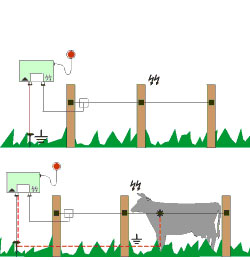

Please Note - Feel free to contact us on the numbers above for no obligation help

An electric fence is made up of 4 main components:
Mains Fencer / Energiser
These are best for large areas where a permanent electric fence is required. They are always the preferred choice for any electric fence where a 230v supply is nearby as you don't have to worry about batteries needing to be recharged. The power can be taken from a mains energiser unit to the fence and the earth stake by insulated 'Lead Out Cable' which can be buried. This is a low cost insulated steel cable which has the ability to cope with high voltages and has minimal resistance. With a mains energiser, the running costs are very low with no maintenance required - you just switch them on and forget about them!
9v Battery Energiser
These are very mobile fence energisers powered by dry-cell 9v disposable batteries. Very popular for strip grazing and seasonal use by farmers and horse owners alike as they're so portable. Please note that 9v batteries are non-rechargeable and you will need to consider the cost of replacing the battery when it runs out - the larger capacity batteries will last considerably longer and some models of 9v energiser have battery saving features that allow the batteries to last longer and therefore lower running costs.
12v Battery Energiser
Ideal for semi-permanent electric fences or where no mains power is available. These energisers are powered by a rechargeable 12v battery and are generally able to power longer fences at a higher voltage than 9v energisers. While a car battery can be used, it is always better to use a 'leisure' battery because a car battery gives out maximum power over a few days and then the power dwindles over the weeks whereas a leisure battery is designed to give a steady output over the weeks and will then go from full strength to flat in a couple of days. This is termed 'deep discharging'. Please consider when buying a 12v leisure battery, the higher the Ah of the battery, the longer between recharges.